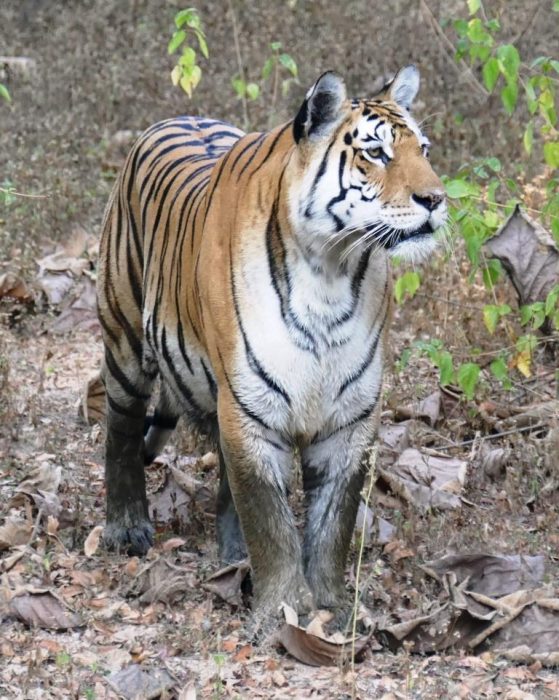
Wildlife conservation and rural development have been pitted against each other for as long as the two fields have existed. But what happens if you view the struggles in and around protected areas across the world from a wider, and perhaps, more inclusive view? What happens if we take a non-judgmental puzzle-solving or exploratory view of how protected areas and local communities interact?
Nowhere in the world are these questions more difficult to ask and yet important to answer than in one of the world’s most densely populated countries with ongoing human resettlements for tiger conservation. India is mega-diverse, but it shouldn’t be – given that more than 1.2 billion people live on one-third the land area of the USA. Lions, tigers, elephants, gaur (Indian bison), and other conservation important species live cheek to jowl with humans across the country. India, incredibly, is the last refuge for many endangered species.
In central India, the value of tigers is undeniable – culturally, ecologically, and economically. Kanha National Park (KNP) typifies the central Indian tiger landscape with high densities of tribal local populations, a globally recognized node for tiger conservation and ecotourism within a rapidly urbanizing countryside. The National Tiger Conservation Authority (NTCA) set out a policy that has resulted in largely tribal human communities moving out of core tiger habitat (1). Around 850 households moved out of KNP (from 2011- to 2014) with monetary compensation, providing an opportunity to explore what happens after.

Image courtesy Amrita Neelakantan
Studying resettlement impacts requires observation of the world around and outside the protected area (in this case, the Kanha National Park). Conservationists additionally and necessarily require to look outside the boundaries of protected areas as animals do not recognize these boundaries and roam the region as they best might be able to. The contiguous or close patches of non-protected forest provide a vital function – they are wildlife corridors allowing for genetic mixing of animal populations, in turn providing for genetically sound future generations (2) (3).
In this specific case, the corridors are paramount to maintaining India’s and the world’s tigers. 70% of all tigers are found in India, and of those, 40% are found in central India. KNP is well-known as a critical node to maintain the central Indian tiger population. So, did the resettlement affect tiger habitats outside while easing up pressures on habitats within KNP? Essentially, did the current resettlement impact long-term conservation by people moving into corridors that remain unprotected? We found that, in the case of KNP, they did not, due to three reasons – the number of resettled households made up a small percentage of the village they moved to; resettled households use the forests less than the existing community; and, finally, only about one percent of resettled households moved to villages that were already within the tiger corridors.
So, clearly in a win for conservation, people moved out of core tiger habitat (KNP core areas) and did not degrade connecting patches of non-protected forests (well – not compared to everyone else who already live there). However, this tells us nothing about the consequences for people, and so we looked at a clear change that might follow from people moving out of core tiger habitat. Logically, resettlement from inside a protected area with a big cat population could mean the chance to escape the human-wildlife conflict.
That does not seem to have happened. Tigers, leopards, sloth bears, and wild dogs all call KNP home, and all these wild animals (predominantly predators) in close quarters can cause loss of life, injuries, and attacks on cattle as well as people. Furthermore, as terrorizing as wild animal attacks on people and cattle can be, they are infrequent when compared to the extensive losses caused by wild animals raiding croplands (wild pigs, deer, etc.). In the KNP landscape, the resettled households may have stayed clear of the corridors but they remained close to the park in non-forest areas. Proximity to the park has positioned them in the recognized zones of human-wildlife conflict (4).
Researchers sometimes stumble into finding policy-relevant tweaks by simply observing what the inhabitants of their study area are doing. Observational studies are, in essence, researchers making sense of what already exists. In that vein, the study finds that respondents hinted at a possible way forward in their interview responses. Households with diversified off-farm incomes were less likely to have a reliance on forests. Urbanizing livelihoods might lead to fewer households using forests and, therefore, encountering wild animals less often.

The study area. Image courtesy Amrita Neelakantan
In the KNP landscape, the current resettlement panned out this way, but in other landscapes, the patterns could be different. Resettled people from other national parks are perhaps pushed into corridors with even higher conflict risks, or, alternatively, people could leave the landscape altogether. The point remains that too often, the nature of people-park interactions remain gridlocked in ideological conflict (legitimate and necessary as a starting point, but too often also becoming the endpoint), and using results from quantitative studies can provide a more nuanced view of such acute competition for natural resources and land.
Studies of policy impacts, like this one, allow future interventions to focus on what matters (continued watch of use of corridors, but perhaps more importantly, higher involvement in reducing the losses due to human-wildlife conflict). Furthermore, the study provides information for replication in other landscapes to better manage the needs of both wildlife and people in landscapes where coexistence might succeed against all odds. The Indian subcontinent is a testament to this possibility because people and wildlife have coexisted through millennia. In India, the cultural backdrop, as well as these advances in interdisciplinary methods, can now allow researched to analyze how humans and wildlife might continue to thrive.









